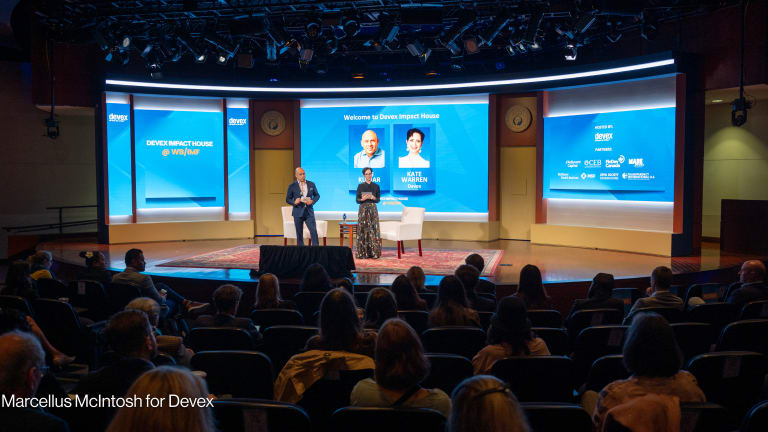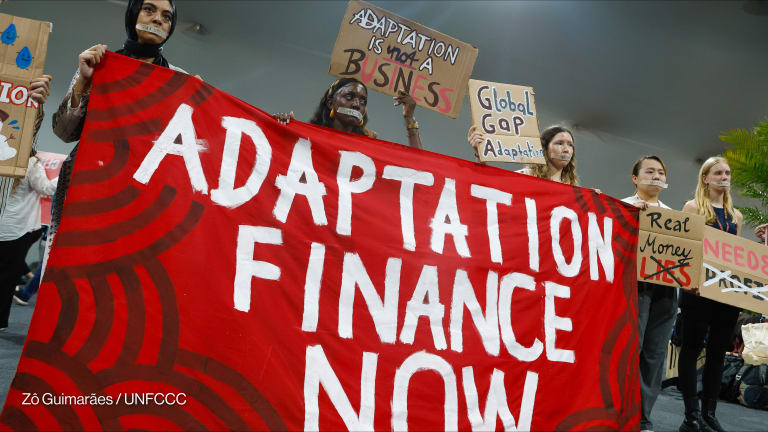Impact investing: Not just for Wall Street types, NGOs are in too
Over the past decade, many NGOs have set up impact investing operations. Devex spoke to several of them to find out what they've learned along the way.
When you think about impact investing, international nongovernmental organizations don’t usually come to mind. You might rather picture private investors, fund managers, and Wall Street types looking to make a buck or two while creating impact. NGOs are typically more focused on implementing aid programs than on investing in businesses and earning returns. But in reality, a group of NGOs have been involved in the impact investing sector for about a decade, motivated by a desire to fill market gaps, better drive impact, and diversify funding streams. Their entrance into the market has sometimes been met with skepticism, either internally or externally, with some questioning whether NGOs have the right skill set or knowledge, and whether they actually have something different to offer than more traditional players. When they jumped in, NGO leaders argued that they were well positioned to take certain risks and that their local networks and knowledge could be a real benefit to companies they invest in. In practice, though, connecting investments to their networks and programs has proven a challenge. Such organizations have come a long way and adopted numerous different approaches, management structures, and funding streams, adapting as they learned the ropes. But they’ve had mixed success and faced some challenges. “The market is still developing so I don’t think anyone has figured it out,” Lauren Ferstandig, managing director of NatureVest, The Nature Conservancy’s impact investing team, told Devex. “I think it needs to keep evolving.” Some NGOs have invested their own money. Heifer Impact Capital, funded by Heifer International’s endowment, has committed $17.2 million to 28 investments ranging from a farmer-owned Rwandan dairy company to financial institutions to spur their lending to farmers. Others have partnered with existing managers to help design new funds. The Africa Conservation and Communities Tourism Fund, for example, was developed and structured by investment manager ThirdWay Partners, while NatureVest developed the conservation and impact targets along with its governance. Several have also opted to set up more traditional-looking investment operations, including Mercy Corps Ventures and Save the Children Global Ventures. And while some have been successful, others gave up and got out of the impact investing game altogether. Each NGO has articulated a different purpose, and in some cases are still trying to determine their place in an often complicated, competitive, and crowded industry. It’s not been easy and has required a lot of adaptation, several NGO impact investing leaders said. Few of these NGO impact investing efforts have scaled dramatically and the space “is not getting all that much recognition,” Preeth Gowdar, chief investment officer of Save the Children Global Ventures, told Devex. The impact investing industry has grown exponentially in the past decade, going from about $9.2 million committed in 2014 to $82 billion in 2022, according to Global Impact Investing Network research, though the way they collect data has changed over time. With so many players in the market, some of the early arguments around filling gaps or diversifying capital haven’t exactly borne out, some experts told Devex. It means that to some degree the role of NGOs in the sector is still up for debate. While questions remain about the role of NGOs in the impact investing space, those who have taken this foray into the world of private capital have learned a lot along the way, including what is critical to make it work. Identify a vision The first question NGOs should ask themselves is why they want to get into impact investing at all. NGOs must ask “Why you?” said Brian Vo, Connect Humanity's chief investment officer, who once led the now-defunct Pact Ventures. What distinct advantage or unique perspective does the NGO have that doesn’t already exist? It also needs to make sense strategically with the core business of the organization, he added. Other impact investors likely have established teams, investment track records, and experience working with and building companies. NGOs should avoid just replicating what the private sector does, Vo said. The real opportunity is “to fundamentally create a new kind of investment approach and investment structures that really are tied into the core strategy of the organization, rather than just separate efforts.” “What do NGOs have to offer is the big question that I think every single NGO is trying to tackle and every single one has a different thesis on what additionality they’re bringing into the space,” Global Ventures’ Gowdar said. NGOs are quick to mention one key differentiator: a large global network with expertise, relationships, and resources on the ground. While such global networks could offer a path to scale for companies they invest in, so far it has not happened as often as NGOs expected. In some cases, NGO impact investing branches have tried to connect the companies they invest with their traditional grant-funded programs and donors, but most often it has been more opportunistic than replicable. Save the Children Global Ventures, for example, invested in ThinkMD, which helps community health workers diagnose patients. Save the Children runs many health programs with community health workers, so it seemed a natural fit to get those programs to adopt ThinkMD’s technology — a move that could help the company scale, and better serve the communities supported by the aid programs. It’s the type of crossover between investing and aid branches that NGOs thought would be a key differentiator, but it’s proven difficult. They want to prove that it is possible but “it’s a work in progress,” Gowdar said. “It’s hard to plug these highly entrepreneurial companies into these NGO systems around the world but when it can be done it really is additional for these companies.” Choose a management structure NGOs have structured their impact investment businesses in different ways, but it is critical to identify the right management structure for what they seek to accomplish, several NGO impact investing leaders told Devex. Some have spun off units to gain independence, while others have stayed fully integrated in the NGO. Some have raised capital from investors, others use the NGO’s own money or partner with existing private fund managers. They have also chosen to focus on different types of investments, some on venture capital, others on debt or other instruments. Leaders of these impact investing efforts didn’t advocate for one model or another, but said that finding the right fit for the organization is key. From a strategic decision-making standpoint, independence from the NGO is important, Scott Onder, chief investment officer of Mercy Corps and co-founder of Mercy Corps Ventures, said. It’s possible for NGO impact funds to be “highly aligned with and connected to and integrated within the wider organization strategy, but in terms of decision making and being able to be nimble and responsive to the needs of entrepreneurs you need to be able to move fast and in a disciplined way.” For Mercy Corps that meant spinning off Mercy Corps Ventures with separate governance and oversight and greater independence. That allowed it to create a long-term investment strategy that is somewhat insulated from organizational changes and politics, Onder said. Save the Children Global Ventures, a much newer entrant to the space, has also gone this route, spinning off a separate entity. It was important “to have a little bit of flexibility and working in new ways while still leveraging the assets of the main NGO,” Gowdar said. Both organizations operate venture capital or investment funds. But The Nature Conservancy and its impact investing arm NatureVest have taken a different approach. NatureVest is wholly part of The Nature Conservancy. It doesn’t manage any funds itself but rather partners with fund managers to design new investment instruments, handling the environmental and impact requirements while the partner handles the financials. NatureVest, for example, may advise and be a part of a fund managed by a private manager where it doesn’t control financial decisions, but it guides the conservation aspects of the deals. It can turn down a deal that would do harm to the environment or to people, for example. Heifer International's impact work also remains within its programmatic function, and it is privately funded through a line of credit from the NGO’s foundation. The investments are closely tied to the agriculture value chains where it focuses and helps farmers globally earn a living income, Jensyn Hallett, the director for impact capital at Heifer International, told Devex. Heifer invests in financial institutions creating the loans farmers need, and supports farmer-owned businesses that process products and can help ensure better profits. Understand the market NGOs must learn, study, and respect the market. They have to find the unique overlap in the Venn diagram of what the market wants, what investors want, and what the NGO wants, several of these NGO impact investing leaders said. “One of the biggest learnings of our time at Naturevest was that even if you develop something that is investable, it delivers cash flows, it delivers a financial return, it delivers measurable outcomes, it all works, it’s not always going to be an easy investment for investors,” Ferstandig said. It is critical to find out what type of investment products investors are comfortable with. New markets and new products can be difficult, but investors are often willing to accept changes to what they’re used to in financial transactions; just not too many, she said. And the demands are evolving — fund managers that once dismissed NatureVest are now open to partnering when faced with changing regulations and investor demands, Ferstandig added. But NGOs shouldn’t underestimate the market, the challenges they could face, or the data, numbers, and financial basis they need to prove to be a player. It’s a world where fundraising looks a lot different than it does with donors and grants, Gowdar said. It can require a mindset shift, a cultural shift, and a good bit of humility, which doesn’t always come naturally to NGOs, experts said. Part of that means that NGOs need to be disciplined in creating a track record and relying less on their reputation or the story of the impact. They have to be able to say no to deals that won’t deliver financial returns, even if they might have a lot of impact, which might run counter to typical NGO instincts. “NGOs need to go slow and be super thoughtful and careful,” Gowdar said. Hire the right people NGOs often don’t have the expertise needed to do impact investing, so a unanimous recommendation from NGO impact investing leaders is that hiring the right team is critical. The team should have experience operating in the sectors and markets where the NGO wants to invest. They must be able to bridge the gap between program experts and finance people, and may need to “wear a program hat one day, wear a country director hat the next day, but then wear a Wall Street hat the day after that,” Vo said. It goes beyond the immediate team, too. It’s important to have legal, accounting, and operations talent that understands how to work in the investment management space. Be flexible Flexibility is key; every NGO Devex interviewed changed its model or tweaked its focus over time. “The biggest learnings have really been around how to build a nimble and adaptable investment strategy that invests in resilience,” Onder said. “Start small and test out different approaches and focus on approaches that are filling gaps that are aligned with your mission and strategy.” While Mercy Corps’ investments in climate adaptation solutions — when most funders were focused on mitigation — have delivered, it was less successful in supporting companies targeting youth employment, at least so far. So in that sector Mercy Corps took a more grant-focused approach, including supporting an incubator and accelerator for job-tech solutions. That also means that NGO leadership must be willing to allow failure and iteration. Part of that is about ensuring they have the right risk appetite to enter into a new field. Leadership needs to be patient, be open to learning, and not push for profitability or scale too quickly, Vo said.
When you think about impact investing, international nongovernmental organizations don’t usually come to mind. You might rather picture private investors, fund managers, and Wall Street types looking to make a buck or two while creating impact.
NGOs are typically more focused on implementing aid programs than on investing in businesses and earning returns. But in reality, a group of NGOs have been involved in the impact investing sector for about a decade, motivated by a desire to fill market gaps, better drive impact, and diversify funding streams.
Their entrance into the market has sometimes been met with skepticism, either internally or externally, with some questioning whether NGOs have the right skill set or knowledge, and whether they actually have something different to offer than more traditional players. When they jumped in, NGO leaders argued that they were well positioned to take certain risks and that their local networks and knowledge could be a real benefit to companies they invest in.
This story is forDevex Promembers
Unlock this story now with a 15-day free trial of Devex Pro.
With a Devex Pro subscription you'll get access to deeper analysis and exclusive insights from our reporters and analysts.
Start my free trialRequest a group subscription Printing articles to share with others is a breach of our terms and conditions and copyright policy. Please use the sharing options on the left side of the article. Devex Pro members may share up to 10 articles per month using the Pro share tool ( ).
Adva Saldinger is a Senior Reporter at Devex where she covers development finance, as well as U.S. foreign aid policy. Adva explores the role the private sector and private capital play in development and authors the weekly Devex Invested newsletter bringing the latest news on the role of business and finance in addressing global challenges. A journalist with more than 10 years of experience, she has worked at several newspapers in the U.S. and lived in both Ghana and South Africa.








